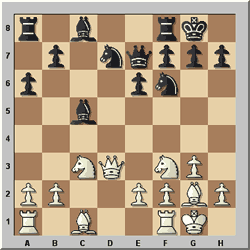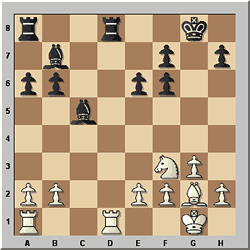 The
chess duel Man vs Machine, Vladimir Kramnik vs Deep Fritz is being staged from
November 25 until December 5th. It is sponsored by the RAG
AG, one of Europe's largest energy companies. The venue is the National
Art Gallery in Bonn, Germany. Schedule:
The
chess duel Man vs Machine, Vladimir Kramnik vs Deep Fritz is being staged from
November 25 until December 5th. It is sponsored by the RAG
AG, one of Europe's largest energy companies. The venue is the National
Art Gallery in Bonn, Germany. Schedule:
| Game 1: |
Saturday |
25.11.2006 |
15:00 h |
| Game 2: |
Monday |
27.11.2006 |
15:00 h |
| Game 3: |
Wednesday |
29.11.2006 |
15:00 h |
| Game 4: |
Friday |
01.12.2006 |
15:00 h |
| Game 5: |
Sunday |
03.12.2006 |
15:00 h |
| Game 6: |
Tuesday |
05.12.2006 |
15:00 h |
There will be full live coverage on the Playchess
server, as well as on the official
site and a number of partner sites.
Game one
Analysis by GM Yasser Seirawan
A few introductory comments to the latest Man versus Machine challenge. In
the pre-match press conference, Vladimir Kramnik opined that because the computer
hardware speeds were getting faster all the time, allowing programs to see an
ever increasing number of ply, the window of opportunity for making such contests
was closing. He hoped that it would not close on him!

Yasser Seirawan analyzing with the Fritz Team (Mathias Feist, left, and
Alex Kure)

Finding a sure-fire win for Kramnik
Speaking on behalf of Deep Fritz 10, Matthias Wüllenweber, expressed an opinion
I had not heard before. He was answering a question as to why Fritz 10 had not
entered into the latest computer competitions such as Turin 2006? Matthias
explained that preparing for a match against the world champion as opposed to
a computer opponent was not the same thing. That a lot of preparation was necessary
as the opponent was so different! The programmers live in fear that the human
player will shut down the position and lock up the pawn structure. The program,
unable to calculate long forcing sequences, plays without understanding and
the programmers are humiliated. Such a situation is really a problem when playing
Vladimir Kramnik but is not a problem when playing against computers. Against
computers a different kind of preparation was necessary and the team of Fritz
10 felt it was best to use their preparation time for the human match and not
a computer challenge. It was quite an irony to hear this side of a familiar
discussion amongst humans.
Now to game one. In his matches with Deep Blue, Garry Kasparov was quite cagey
with the White pieces. In order to avoid certain defensive lines he would play:
1.Nf3, trying to steer the computer into the type of (closed) game that he was
aiming. In contrast, for game one at least, Vladimir just gets on with business.
Vladimir Kramnik - Deep Fritz
Man vs Machine (1), Bonn 25.11.2006 – Catalan Opening [E03]
1.d4 Nf6 2.c4 e6 3.g3. Repeating the Catalan Opening which he used to
good effect in his recent match with Veselin Topalov. In principle, an excellent
opening choice against the computer as the strategic positions that arise are
extremely subtle. Without making an obvious error the Black side can be put
under long term pressure that continues even into the endgame. On the other
hand, there is much to be said for: 3.Nc3 Bb4 4.Qc2, just planning to win the
two Bishops and hope that the computer will allow a slow buildup thereafter.
Happy thoughts of his last round win over Peter Leko in Dortmund 2006, is the
type of ending Vladimir might try to repeat.
3...d5 4.Bg2 dxc4! While there is nothing wrong with: 4...Bb4+ 5.Bd2
Be7, and an eventual ...c7-c6 playing the Closed Catalan, there are dangers
present in these lines. White might get a queen-side clamp and the computer
might not realize that a certain moment a central break is required. By the
text, the computer insures at least a semi-open game and the danger of being
dominated in a closed position passes by at an early stage.
5.Qa4+. In general, most Catalan players are not afraid of losing the
c4-pawn and often prefer not to recapture it at once. However, sacrificing
material against a human is one thing, against a computer Vladimir might never
get the pawn back.
5...Nbd7 6.Qxc4 a6 7.Qd3. Up to this point, Vladimir could see the computer's
monitor as the players were still in "book" or rather opening theory. After
the text, Deep Fritz or Fritz 10 was out of book and the monitor was turned
away from Vladimir. However, a few moves later, the game had transposed back
into opening theory and Vladimir could again observe the computer's monitor. The
text sidesteps a quick ...c7-c5 and ...b7-b5 which would come with tempo. White's
early Queen moves aren't particularly effective in terms of playing for an opening
advantage.
7...c5. Annoying. Okay, the text is a perfectly normal move but Vladimir
could hope that his opening novelty might induce the computer to take another
approach such as playing: 7...Bd6, aiming for ....e6-e5 which is not a particularly
good idea. 8.dxc5 Bxc5 9.Nf3 0–0 10.0–0 Qe7 11.Nc3.
Thus far the game has followed along what could be described as normal channels
but the first real question has been laid before Deep Fritz 10: Would it play
11...b6 or 11...b5 and why? I'm not sure which of the two is best. On the
one hand an argument for 11...b5 can be made that Black takes control of the
c4-square and keeps the b6-square open. Also, after 11...b5 a future ...b5-b4
might be a useful tempo. On the other hand, a future a2-a4 might undermine
the Queenside. A difficult choice and an intriguing moment into the insight
of how Deep Fritz 10 plays.
11...b6. 12.Ne4! An excellent moment to clear the board of some pieces.
White cannot become complacent. It is clear that after ...Bc8-b7, Black will
bring a rook to the d-file and suddenly White could find his queen harassed.
The text preempts the potential for such problems. Naturally, 12.Nd4? Ne5!,
would only result in problems for White.
12...Nxe4. Further insight into how Fritz 10 plays. The text shows a
prejudice for Bishops. A reasonable alternative was: 12...Bb7 13.Nxc5 Nxc5
14.Qa3, when White's Queen is safe from further harassment. White has won the
two Bishops but Black's harmonious development gives a comfortable game as well.
13.Qxe4 Nf6.
14.Qh4! Following the KISS principle (Keep It Simple Stupid). Against
a human player the line: 14.Qxa8 Bb7 15.Qxf8+ Kxf8, with two rooks for the Queen
deserves consideration. After all the c and d-files are both open and offer
good avenues for the rooks. However, if we continue the line several ply further
for example: 16.b3 e5! 17.Bb2 e4 18.Ne5 e3!, the human player starts to feel
uncomfortable. There are some dynamic factors lurking in Black's favor and
the rooks have hardly had a chance to flex their muscles.
One possible thought to consider is whether Deep Fritz 10 had seen this line
and judged that in case White opted to win the two rooks for a queen, that in
this case, a supporting b6-pawn to the c5-Bishop was better placed.
14...Bb7 15.Bg5 Rfd8 16.Bxf6 Qxf6 17.Qxf6 gxf6 18.Rfd1.
On the one hand, Vladimir can be pleased. He has managed to channel the game
into the quiet waters of an ending. Best of all Black has doubled f-pawns which
gives rise to a certain optimism. On the other hand, Vladimir has no advantage
whatsoever. Vladimir is "gambling" that Deep Fritz will not play
the correct move...
18...Kf8? The gamble is successful. Most human players would have played
18...Bxf3! and offered the world champion a halving of the point. Vladimir
correctly understands that the computer would look at the wonderful open-range
b7-Bishop, see the puny short-hopping f3-Knight and refuse a trade. While Deep
Fritz can see 18 ply deep and even more in certain positions, it is unable to
deduce that the f3-Knight has the potential of being a superior piece to the
c5-Bishop.
19.Ne1! After this move, White has a serious endgame advantage. Of
course from this moment to the end of the game Deep Fritz 10 was showing that
the game was always equal or perhaps at most a 0.18 advantage for White. In
actuality, of course, White's winning chances are excellent.
19...Bxg2 20.Kxg2 f5 21.Rxd8+ Rxd8 22.Nd3 Bd4 23.Rc1. In my day, players
like Ulf Anderson (Sweden) and Zoltan Ribli (Hungary) made an excellent living
from such endgame positions as White. Time and again they would demonstrate
that White's control of the c-file was more important then Black's d-file control.
That Black's king-side structure was a serious liability and that given time;
White's King could play a more active role in the endgame then its counterpart.
23...e5! More annoyance. The computer refuses to go quietly into that
good night. White just wanted to play moves like f2-f4 and Kg2-f3 to really
get his positional grippers latched on to the position. The text interferes
with this delightful dream by creating counter-play based on ...e5-e4 and also
keeps White's King at bay.

Kramnik ponders the position after the move 23...e5!
24.Rc2! Simple chess. Vladimir covers the b2-pawn as well as protecting
the d2-square against any invasion. He now awaits developments, perhaps Deep
Fritz, with a wide range of pawn moves would weaken its position?
24...Rd5? Whoa! This hyper-active move was certainly a surprise. I
was having some doubts about White's winning chances after 24...a5, preventing
a possible Nd3-b4-c6 idea. In that case, 25.e3!? e4 26.exd4 exd3 27.Rd2 Rxd4
28.f4! (28.Kf3 f4! 29.gxf4 f5), leads to a likely drawn rook endgame but White
after a subsequent Kg2-f3-e3 and vacuuming up the d3-pawn might have something
to enjoy. After all the doubled f-pawns have some kind of disadvantage. After
the text, I really got excited about Vladimir's winning chances. Now he can
force a classic good knight versus bad bishop minor piece endgame with excellent
winning chances. A situation that would be well beyond the computers horizon.
25.Nb4! Rb5. In passing, I should note that my Fritz 9 engine rated
the text as well as 25...Rc5, as about even. Needless to say, after: 25...Rc5
26.Rxc5 bxc5 27.Nxa6 c4 28.b3 c3 29.Nb4, White, a pawn to the good, wins easily.
26.Nxa6.
Suddenly, there are many pitfalls in the position for Black. For example:
26...Bxb2 27.Nc7 Rb4 28.Nd5 Rb5 29.Ne3 f4 30.Nf5, with both the threat of a
back-rank checkmate as well as a plan of Kg2-f3, when we see an example of how
White's King can become far more active then its counter-part. Another nice
trapping line could be seen after: 26...Bxb2 27.Nc7 Rc5 28.Rxc5!? bxc5 29.Nd5
c4 30.Ne3 c3 31.Kf1, when White's King races to blockade the passed c-pawn.
26...Rxb2 27.Rxb2 Bxb2 28.Nb4. This is one of those moves that I find
difficult to explain. At the time, I was convinced that Vladimir should win
by: 28.Nc7!, in order to "freeze" the Black King and to quickly bring
the knight to the wonderful d5-square. My arguments were quite convincing,
at least to myself. Then Vladimir played the text and I was left wondering
what the difference was? Now, I'm unable to recall. 28...Kg7 29.Nd5 Bd4.
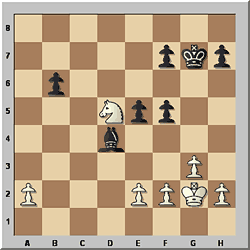
Thus far we can only express our admiration for Vladimir's sterling anti-computer
play (and in general his fine play overall). He is literally at the precipice
of victory while Deep Fritz 10 is happily producing 0.00 evaluations. The game
is won and this is the moment. At the time of play, I thought the win was simple:
White should play a2-a4, e2-e3, march the King to the b5-square and make sure
that Black had insufficient opportunity to penetrate on the king-side with his
King. Now, of course, I realize that the move a2-a4 is not critical to this
line of play and that it might even be helpful if Black can be coaxed into playing
...b6-b5 bringing the pawn closer to its own execution.
30.a4? Missing the direct path to victory. After: 30.e3! Bc5 31.Kf3!,
the win is as clear as a sunny sky. White's King is making a beeline to the
b5-square, where the b6-pawn is captured and the a-pawn is escorted to coronation.
I see no defense: 31...f6, prepares to bring the Black King to the center.
Black is welcome to march his King to the g5-square when h2-h3 shuts the door
to further progress. White continues: 32.Ke2, executing his plan. Now Black
has a choice. He can play: 32...e4, delaying White's King march by a move or
not. Keep in mind that: 32...e4, gives up the f4-square, let us judge: 32...Kf7,
as the main line. White continues his march: 33.Kd3 Ke6 34.Kc4, and White has
achieved his ideal. Black is in Zugzwang. His Bishop cannot leave the protection
of the b6-pawn and Black's King is fastened to the protection of the f6-pawn.
White's win is simple: he just plays a2-a4 with the threat of a4-a5 when the
Bishop is undermined. White wins.
Because this main line is so convincing, Black would likely have to try a line
combining ...e5-e4 and even ...b6-b5 as well but I view the ending as hopeless.
Let us check: 30.e3 Bc5 31.Kf3 f6 32.Ke2 e4 33.Kd2 b5 34.Kc3 Kf7 35.Nc7 Bb6
36.Nxb5, let us pause to give thanks. White has achieved our favorite living
condition, he is a pawn ahead. Black can continue with: 36...Ba5+ 37.Kd4 Be1,
however, this counter-play is far too late. White ignores the loss of the f2-pawn
and with: 38.a4, Black can give it a rest.
30...Bc5 31.h3? This is a real groaner. I think the text throws away
most of the winning chances that were left. I was still wildly optimistic about
White's chances after 31.Kf3! One point is to trick the computer into playing
an innocuous move like: 31...Kg6? After which White plays: 32.e3!, and he is
back in business as his King goes to the b5-square as we have seen. If Black
plays: 31...e4+? 32.Kf4 Kg6 33.Ke5 gives White the active King and a simple
win. The main question is: 31.Kf3 f6 and can White still win? Black is now
prepared for ...Kg7-f7-e6 booting away the overpowering d5-Knight. My attention
had been focused on: 32.e4, inviting the line: 32...fxe4+ 33.Kxe4 Bxf2 34.Kf5,
playing for the simple recapture of the f6-pawn. White appears dominant. Therefore,
31.Kf3 f6 32.e4 Kg6, when we come to the major difference between this line
and the game continuation, White can provoke Black into playing ...f5xe4 under
favorable circumstances: 33.Ne3!, now after: 33...fxe4+ 34.Kxe4, White has achieved
what he wants, an active King. While after: 33...Bxe3 34.Kxe3, White has a
winning King and pawn ending.
31...f6 32.f3 Kg6.
33.e4?? The final unbearable mauling of this favorable ending. Although
my optimism was seeping away I still felt that Vladimir had not tossed away
his whole advantage. Now was the time for 33.e3! awaiting developments. If
Black falls asleep, then the plan of Kf1–e2-d3-c4 will force a rude awakening.
White's dream is revealed after: 33.e3! h5 34.Kf1! Kf7 35.Ke2 Ke6 36.e4, now
the difference in the game is crystal clear, Black's King on e6 is not offered
any king-side counter-play: 36...fxe4 37.fxe4 f5 38.Kf3 Bd4 39.Ne3! fxe4+ 40.Kxe4,
and White's King has reached the square of milk and honey.
33...h5! Whoops. Now White finds himself in Zugzwang. If his King
was on e2, then Ke2-d3 and just wins. Unfortunately, White's King has to stay
close to the e4-square as: 34.Kf1 fxe4 35.fxe4 f5, and White can't maintain
his light-square blockade. Vladimir now went into a long pause and was horrified
to realize that he had done the one thing that he was trying hard to avoid:
Leaving a king-side pawn weakness.
34.g4 hxg4 35.hxg4 fxe4 36.fxe4 Kg5 37.Kf3 Kg6 38.Ke2 Kg5 39.Kd3 Bg1!? A
bit of a surprise. Most of us would have played: 39...Kxg4 40.Nxf6+ Kf3 41.Nd7
Bd4, and awaited a draw offer. 40.Kc4 Bf2 41.Kb5 Kxg4 42.Nxf6+ Kf3 43.Kc6
Bh4 44.Nd7 Kxe4 45.Kxb6 Be1 46.Kc6 Kf5 47.Nxe5 Kxe5 ½–½.

The game nears its end

Kramnik takes the last black pawn with 47.Nxe5 Kxe5...

...and then offers the draw.
The post-game press conference was an unusual experience. Vladimir was asked
if he felt he had realistic winning chances and he answered that he thought
so but was not sure where he had gone wrong, whereas the Fritz team thought
the game was equal throughout. At least I could still comfort myself with the
thought that, yes, humans can still compete with computers and the window has
not been fully closed.

Vladimir Kramnik and Mathias Feist, the operator of Deep Fritz in the post
gam press conference

Kramnik though he had winning chances, but was not sure exactly where

Mathias Feist says the gravest danger Fritz had displayed was minus 0.4
pawns

The world champion says this type of opening was quite comfortable for him...

...and that he was satisfied with the course of the game. And the draw?
"Well, it is quite difficult to win against the computer."
Links
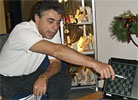













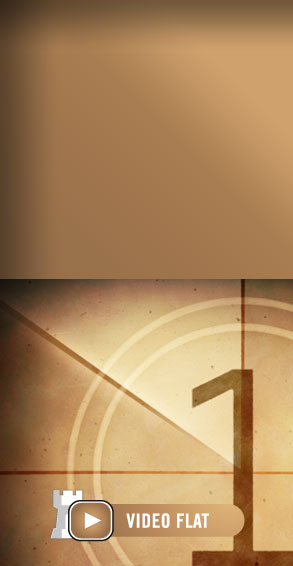

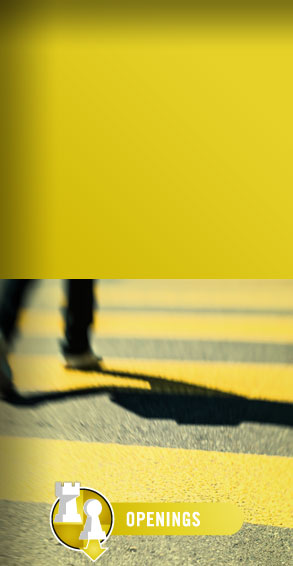

 The
chess duel Man vs Machine, Vladimir Kramnik vs Deep Fritz is being staged from
November 25 until December 5th. It is sponsored by the
The
chess duel Man vs Machine, Vladimir Kramnik vs Deep Fritz is being staged from
November 25 until December 5th. It is sponsored by the 

